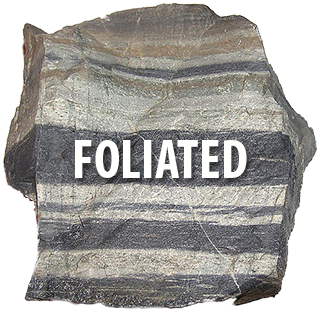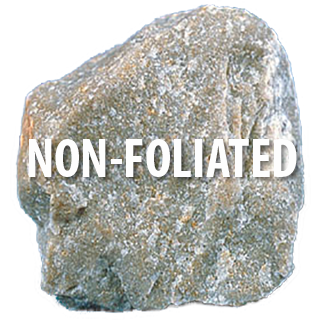
Metamorphic Rocks
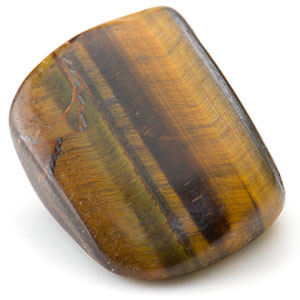
Tiger's Eye, a common metamorphic rock
Typically, metamorphic rocks form miles beneath the surface of the Earth where temperatures and pressures are the highest. The term metamorphic means to change form. This term works for this rock type because metamorphic rocks start out as another rock. This other rock can be an igneous, sedimentary, or metamorphic rock which is commonly referred to as a parent rock. When the parent rock becomes exposed to intense heat and/or pressure, it can change form either physically or chemically. As a result of changing either chemically or physically, it becomes a new rock with a unique method of formation: a metamorphic rock. Cooking food is a good analogy for the process of forming metamorphic rocks. Fruits, vegetables, and proteins all change physically and chemically when they are exposed to high cooking temperatures. In many cases, the original raw food is indistinguishable from the cooked product. The same applies to parent rocks and the resulting metamorphic rock.
Foliated vs. Non-Foliated Metamorphic Rocks
Like igneous rocks, metamorphic rocks are further divided into two subgroups based on mineral textures visible on the surface. The metamorphic rock subgroups are foliated and non-foliated. Roll your cursor over the images below to learn more about foliated versus non-foliated metamorphic rocks.
View a printable version of the interactivity.
Foliation vs. Stratification
It is important that you do not get this confused with the sedimentary term stratification. Stratification is the horizontal layering of sedimentary rocks. Sedimentary rock layers can be many meters thick and appear to be very geometric in arrangement. Think of the perfectly layered rocks of the Grand Canyon. For miles and miles, the layers of sedimentary rock extend in perfectly horizontal layers. With foliation, the layered or striped effect is subtle and on a much smaller scale, much like the stripes of a tiger or zebra. These stripes are less symmetrical.
Metamorphism and Yellowstone
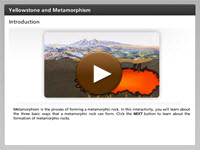 Metamorphic rock forms when rocks undergo heat and pressure. Where on Earth can existing rock experience extremes in heat and pressure? One location in the United States where metamorphism occurs is Yellowstone National Park. Here, all three types of metamorphism occur. In this interactivity, you will learn about these three basic ways. Click the player button to begin.
Metamorphic rock forms when rocks undergo heat and pressure. Where on Earth can existing rock experience extremes in heat and pressure? One location in the United States where metamorphism occurs is Yellowstone National Park. Here, all three types of metamorphism occur. In this interactivity, you will learn about these three basic ways. Click the player button to begin.
View a printable version of the interactivity above.
Common Metamorphic Rocks
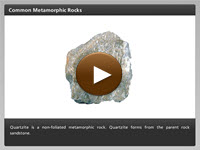 Now that you have learned how metamorphic rocks form, and the textures of metamorphic rocks, it is time to investigate some examples. In the interactivity, you will learn more about each of the common metamorphic rocks. Click the player button to begin.
Now that you have learned how metamorphic rocks form, and the textures of metamorphic rocks, it is time to investigate some examples. In the interactivity, you will learn more about each of the common metamorphic rocks. Click the player button to begin.
View a printable version of the interactivity.
Metamorphic Rocks Review
![]()
 How well do you know the textures of metamorphic rocks? In this non-graded interactivity, read each statement and decide whether it is True or False. Then, select the appropriate answer and click SUBMIT to check your response. Click the player button to get started.
How well do you know the textures of metamorphic rocks? In this non-graded interactivity, read each statement and decide whether it is True or False. Then, select the appropriate answer and click SUBMIT to check your response. Click the player button to get started.



